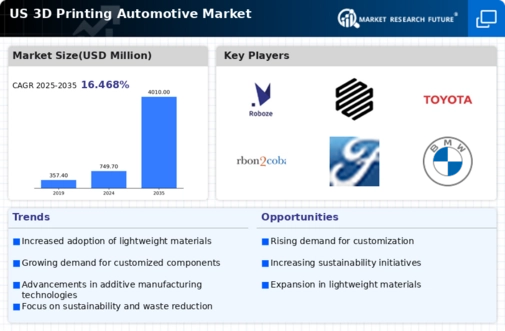The US 3D Printing Automotive Market represents a rapidly evolving landscape where innovation meets advanced manufacturing. As automotive manufacturers increasingly adopt additive manufacturing technologies, the competitive insights reveal a dynamic interplay between established industry players and emerging startups. This market is characterized by its ability to revolutionize traditional manufacturing processes, leading to customized parts, reduced production times, and cost-effective solutions. Factors such as technological advancements in 3D printing materials, increasing demand for lightweight components, and regulatory support for sustainable manufacturing practices significantly shape the competitive environment.
Players in this market continually seek to innovate, improve production efficiencies, and build strategic partnerships to secure their competitive edge.Focusing on Roboze, the company has carved a niche for itself within the USA 3D Printing Automotive Market by emphasizing high-performance polymer and metal-based additive manufacturing. Roboze's strength lies in its cutting-edge 3D printing technology, which caters specifically to automotive applications demanding high precision and durability. Its advancements in materials science allow for the production of lightweight parts that meet high-temperature and pressure resistance standards, making them ideal for automotive manufacturing.
The company has established a strong foothold in the US market through collaborations with automotive OEMs and suppliers, which has bolstered their brand presence and facilitated technological advancements. By prioritizing customer needs and embracing customization, Roboze has demonstrated its commitment to providing superior solutions that drive efficiencies in automotive manufacturing.Markforged, another significant player in the US 3D Printing Automotive Market, specializes in digital fabrication technologies focused on producing strong and durable parts for various automotive applications.
Known for its unique continuous fiber reinforcement technology, Markforged offers products capable of achieving mechanical properties comparable to metal, thus allowing automotive manufacturers to build both functional prototypes and end-use parts. The company's strategic investments in developing composite materials have broadened its product offerings, appealing to diverse automotive segments.
Furthermore, Markforged has been active in forming partnerships and collaborations that enhance its market presence. Its recent merger activity highlights a commitment to growth and innovation, further positioning the company as a leader in the additive manufacturing sector. With its focus on automation and improved production workflows, Markforged continues to empower automotive manufacturers to optimize their production processes and reduce lead times, reinforcing its competitive stance in the US market.























Leave a Comment